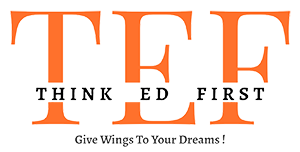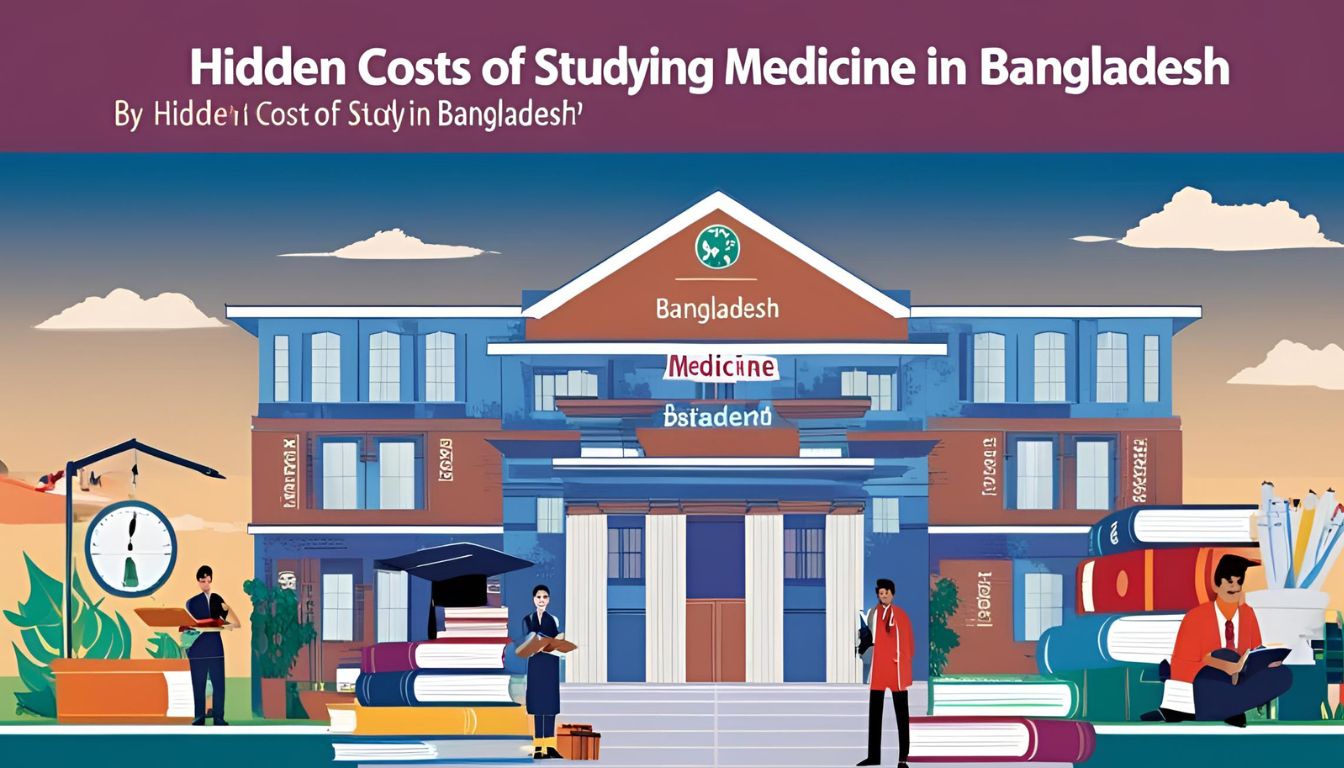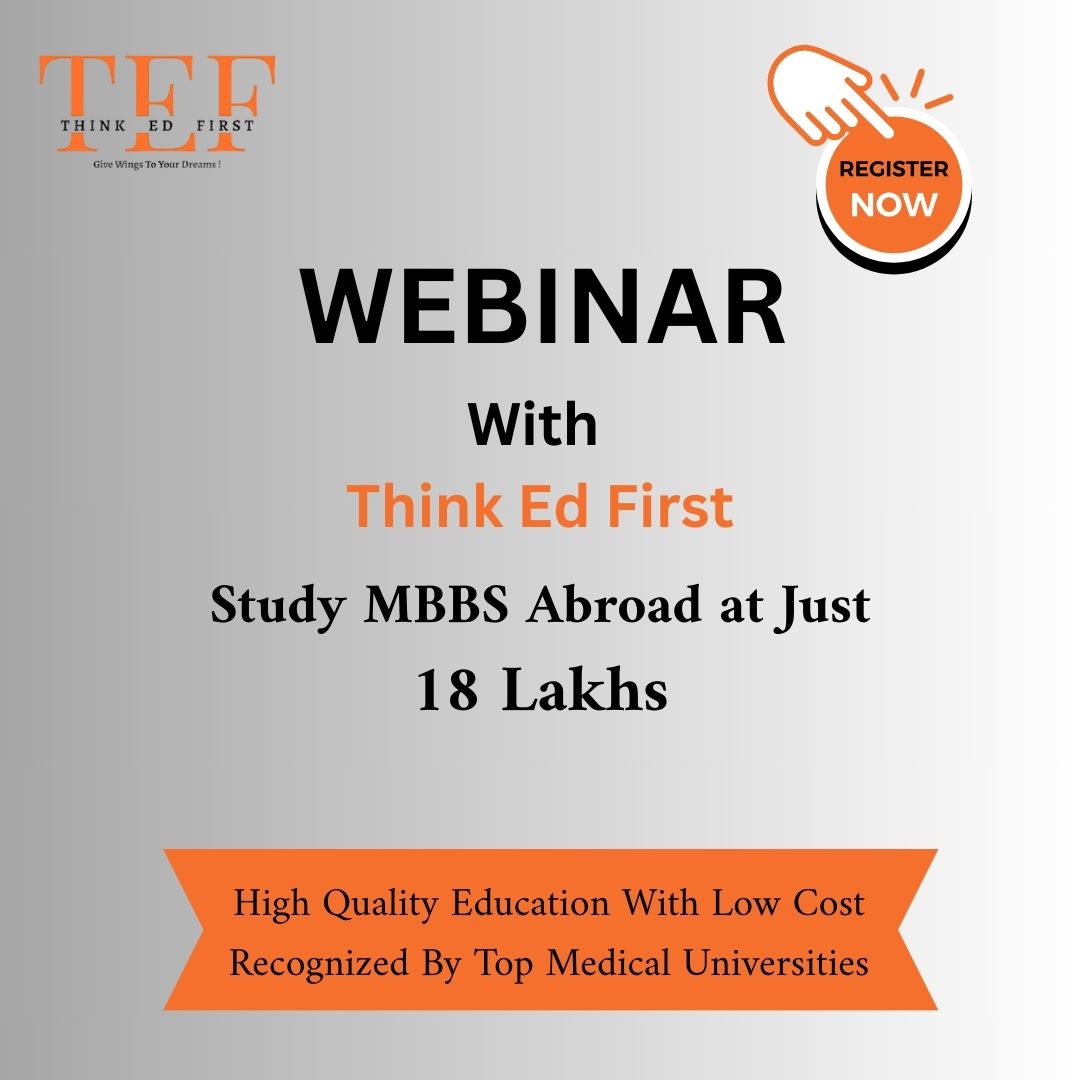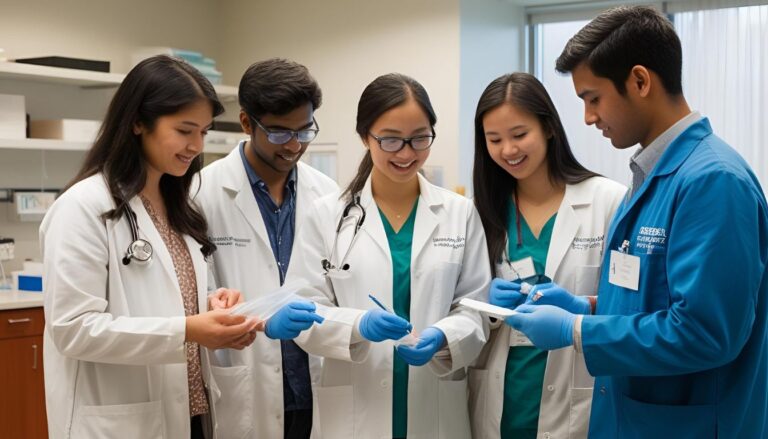When planning to study medicine abroad, most students focus on tuition fees. But is that the whole story? For Indian students considering Bangladesh, there’s more to the financial picture than meets the eye.
Bangladesh has become a popular destination for medical education. Its cultural similarities and NMC-recognized programs make it an attractive choice. However, the expenses don’t stop at tuition. Registration fees, living costs, and academic supplies add up quickly.
On average, the total cost ranges between ₹26.5 lakh and ₹41.5 lakh. This includes everything from hostel fees to exam charges. So, are you ready to uncover the full financial commitment of pursuing a medical degree abroad?
Introduction to Hidden Costs of MBBS in Bangladesh
Pursuing a medical degree abroad seems affordable at first glance, but the reality is different. Many Indian students underestimate the ancillary expenses involved. Studies show that nearly 60% of students fail to account for these additional costs when planning their budget.
While the tuition fees in Bangladesh appear low, the overall expenditure can be much higher. Registration fees, living expenses, and academic supplies add up quickly. This makes the total cost significantly more than what students initially expect.
Medical colleges in Bangladesh are recognized by the WHO and NMC, ensuring the quality of education. However, students must also meet BMDC accreditation requirements, which involve additional fees and documentation.
Currency exchange risks are another factor to consider. As of now, 1 INR equals 1.31 BDT. Fluctuations in exchange rates can impact the total cost for Indian students. Here’s a quick look at the current exchange rate:
| Currency | Exchange Rate |
|---|---|
| 1 INR | 1.31 BDT |
Understanding these factors is crucial for students planning to study in Bangladesh. Proper budgeting can help avoid financial surprises and ensure a smooth academic journey.
Why Tuition Fees Are Just the Beginning
The financial journey of studying medicine internationally goes beyond just tuition. While tuition fees are a significant part of the budget, they are only the starting point. Students often overlook other essential expenses that can add up quickly.
Registration fees, exam charges, and lab fees are just a few examples. These are mandatory and can significantly increase the total cost. For instance, university exam fees alone can range from BDT 10,000 to 12,000, charged multiple times during the course.
Another major expense is the mandatory one-year internship. This is a crucial part of medical education, allowing students to gain hands-on experience in top hospitals. However, it comes with its own set of costs, including accommodation and daily expenses.
Currency fluctuations also play a role. For Indian students, the exchange rate between INR and BDT can impact the overall budget. As of now, 1 INR equals 1.31 BDT, but this rate can vary, affecting the total expenditure.
Here’s a comparison of fee structures for medical education in Bangladesh and Indian private colleges:
| Expense | Bangladesh (Approx.) | Indian Private Colleges (Approx.) |
|---|---|---|
| Tuition Fees | ₹15-22.5 lakh | ₹10-60 lakh |
| Registration Fees | Included/Additional | ₹50,000-1 lakh |
| Exam Fees | BDT 10,000-12,000 (per exam) | ₹5,000-10,000 (per exam) |
| Lab Fees | ₹10,000-12,000 | ₹15,000-20,000 |
Understanding these expenses is crucial for proper budgeting. It ensures students are prepared for the full financial commitment of pursuing a medical degree abroad.
Hidden Costs MBBS Bangladesh: A Comprehensive Breakdown
Understanding the full financial picture of studying medicine abroad is essential. While tuition fees are a major expense, there are other mandatory charges that students often overlook. These include registration fees, exam fees, lab charges, and library fees. Properly accounting for these can help avoid financial surprises.
Registration and Examination Fees
Registration fees are a one-time expense during the admission process. For example, at BSMMU, this can range from ₹50,000 to ₹80,000. Additionally, exam fees are charged semiannually and can vary between ₹15,000 and ₹25,000 per semester. These are essential for progressing through the course.
Laboratory and Library Charges
Lab fees are another significant expense. On average, students pay ₹8,000 to ₹12,000 annually for lab equipment deposits. Pathology lab consumables can cost around ₹3,000 per month. Library membership fees are also mandatory, ranging from ₹5,000 to ₹7,000 yearly.
- Registration fees: ₹50,000-₹80,000 (one-time)
- Exam fees: ₹15,000-₹25,000 (per semester)
- Lab equipment deposits: ₹8,000-₹12,000 (annually)
- Library membership fees: ₹5,000-₹7,000 (annually)
- Pathology lab consumables: ₹3,000 (monthly average)
These fees are common across many medical colleges in Bangladesh. Planning for them ensures a smoother academic journey without unexpected financial strain.
Living Expenses: The Overlooked Budget Drain
Living expenses often take students by surprise when studying abroad. While tuition and academic fees are planned, daily costs can add up quickly. For Indian students in Bangladesh, managing these expenses is crucial to avoid financial stress.
Accommodation Costs (On-Campus vs. Off-Campus)
Accommodation is one of the biggest monthly expenses. On-campus hostels are more affordable, ranging from ₹6,000 to ₹9,000 per month. Off-campus options, while offering more privacy, cost 40% more, averaging ₹12,000 to ₹18,000 monthly.
| Accommodation Type | Monthly Cost (₹) |
|---|---|
| On-Campus Hostel | 6,000 – 9,000 |
| Off-Campus Apartment | 12,000 – 18,000 |
Food and Daily Necessities
Monthly grocery costs depend on food preferences. Indian students often spend ₹5,000 to ₹7,000 on groceries. Eating out or buying imported items can increase this amount. Seasonal price hikes during Ramadan and Eid also affect food costs.
Utilities and Internet Bills
Electricity and water bills average ₹2,000 to ₹3,000 monthly. Using air conditioning can increase costs by 150%. Internet packages, essential for studies, range from ₹800 to ₹1,200 per month.
Properly budgeting for these expenses ensures a smoother experience for students. Planning ahead helps avoid unexpected financial challenges.
Academic Supplies and Equipment
Academic supplies are a crucial part of any medical program. From textbooks to lab gear, these items are essential for success. Students often underestimate the expenses tied to these materials, which can add up quickly.
Textbooks and Reference Materials
Textbooks are a significant expense for students pursuing a medical degree. Annual costs for books like Oxford Handbooks range from ₹15,000 to ₹25,000. Over the course of the program, total book expenses can reach ₹50,000 to ₹80,000.
Digital resources are also becoming popular. Subscriptions to online platforms cost around ₹8,000 yearly. These tools provide access to updated medical research and study materials.
Lab Equipment and Safety Gear
Lab equipment is another essential expense. Surgical instrument kits, required for the entire program, cost between ₹18,000 and ₹25,000. Dissection kits are a one-time purchase, averaging ₹12,000.
Safety gear like lab coats and stethoscopes are mandatory. Three sets of lab coats cost ₹3,500 to ₹5,000. A high-quality stethoscope, such as Littmann, ranges from ₹4,000 to ₹6,000.
| Item | Cost (₹) |
|---|---|
| Textbooks (Annual) | 15,000 – 25,000 |
| Digital Resources (Annual) | 8,000 |
| Surgical Instrument Kit | 18,000 – 25,000 |
| Dissection Kit | 12,000 |
| Lab Coats (3 Sets) | 3,500 – 5,000 |
| Stethoscope | 4,000 – 6,000 |
Properly budgeting for these supplies ensures students are well-prepared for their studies. It also helps avoid last-minute financial stress during the program.
Transportation Costs for Students
Transportation is a key factor for students studying abroad, often overlooked in initial budgets. For Indian students in Bangladesh, getting around involves both local and international travel. These expenses can add up quickly, impacting the overall financial plan.
Local Commute Expenses
Daily commuting is a significant part of student life. In Bangladesh, local transport options include rickshaws, buses, and taxis. A monthly rickshaw or bus pass costs between ₹2,500 and ₹4,000. For late-night travel, emergency taxi rides can range from ₹300 to ₹500 per trip.
Managing these expenses requires careful planning. Students often rely on public transport to keep costs low. However, unexpected trips or late-night travel can increase the monthly budget.
Travel to and from India
Frequent travel between India and Bangladesh is common for students. Roundtrip flights from Kolkata to Dhaka cost between ₹25,000 and ₹35,000. Students typically make 6-8 trips annually for holidays, family visits, or visa runs.
Additional fees, like luggage excess charges for medical books, can add ₹3,000 to ₹5,000 per trip. Visa-run expenses are also necessary to maintain student status. These costs should be factored into the overall budget.
| Transport Type | Cost (₹) |
|---|---|
| Monthly Rickshaw/Bus Pass | 2,500 – 4,000 |
| Emergency Taxi (Per Trip) | 300 – 500 |
| Kolkata-Dhaka Roundtrip Flight | 25,000 – 35,000 |
| Luggage Excess Fees (Per Trip) | 3,000 – 5,000 |
Understanding these transportation costs helps students plan better. It ensures they are prepared for both daily commutes and international travel while pursuing their medical education.
Health Insurance and Medical Emergencies
Health insurance is a critical yet often overlooked expense for students studying abroad. For those attending medical colleges, it’s not just about tuition and living costs. Ensuring proper health coverage is essential for a smooth academic journey.
Most universities require international medical students to have mandatory health insurance. This typically costs between ₹1,800 and ₹2,500 per month. While it covers basic medical needs, some expenses remain non-covered. For example, dental procedures can cost ₹3,000 to ₹5,000 per treatment.
Mental health counseling is another important consideration. Sessions often cost around ₹1,200 each. Vaccination boosters, required for maintaining health standards, add ₹8,000 to ₹12,000 annually to the budget.
In case of emergencies, students may face additional costs. Dengue treatment, for instance, can cost ₹15,000 per episode. Emergency medical repatriation is another potential expense, which can be significant.
- Mandatory health insurance: ₹1,800-₹2,500/month
- Non-covered dental expenses: ₹3,000-₹5,000/procedure
- Mental health counseling: ₹1,200/session
- Vaccination boosters: ₹8,000-₹12,000/year
- Emergency medical repatriation costs
Planning for these expenses ensures students are prepared for any health-related challenges during their studies. Proper budgeting can prevent financial stress and focus on academic success.
Visa and Documentation Fees
Securing a student visa and managing documentation are essential steps for aspiring medical students. These fees are often overlooked but are a significant part of the admission process. Proper planning ensures a smooth transition to studying abroad.
For students pursuing medical education, visa fees typically range from ₹15,000 to ₹25,000. Document attestation costs ₹5,000 per page, which can add up depending on the number of documents required. These are mandatory for meeting eligibility criteria.
Additional expenses include student visa renewal, which costs ₹12,000 annually. A police clearance certificate is also required, costing ₹2,500. Academic transcript attestation adds ₹800 per document, while migration certificate processing costs ₹6,500.
Late document submission can result in penalties, further increasing costs. It’s crucial to stay organized and submit all required paperwork on time to avoid unnecessary fees.
- Student visa renewal: ₹12,000/year
- Police clearance certificate: ₹2,500
- Academic transcript attestation: ₹800/document
- Migration certificate processing: ₹6,500
- Late document submission penalties
Understanding these fees helps students prepare for the financial aspects of the admission process. Proper budgeting ensures a hassle-free journey toward achieving their medical education goals.
Unexpected Miscellaneous Fees
Many students overlook small but significant fees when planning their medical education. These charges, though often minor individually, can add up quickly and strain your budget. Understanding these expenses ensures you’re fully prepared for the financial commitment of studying abroad.
University-Specific Surcharges
Universities often include additional charges that aren’t part of the standard tuition. For example, annual fee hikes of 5-7% are common in many medical colleges. Alumni association fees, which cost around ₹3,500 yearly, are another expense to consider.
Laboratory breakage fines can range from ₹500 to ₹5,000 per incident. Journal subscription fees, essential for staying updated in your course, add ₹4,000 annually. These surcharges are mandatory and should be factored into your budget.
Extracurricular and Club Memberships
Extracurricular activities and club memberships are an integral part of student life. However, they come with their own set of fees. Sports facility charges, for instance, average ₹1,200 per month. Cultural events often require mandatory contributions, which can vary depending on the activity.
Club memberships, such as medical societies or debate clubs, cost around ₹10,000 annually. While these activities enrich your experience, they also add to your overall expenses. Planning for these fees ensures you can participate without financial stress.
- Alumni association fees: ₹3,500/year
- Laboratory breakage fines: ₹500-₹5,000/incident
- Journal subscription fees: ₹4,000/year
- Sports facility charges: ₹1,200/month
- Cultural event mandatory contributions
Currency Exchange and Financial Pitfalls
Currency exchange plays a critical role in managing finances for students studying abroad. For those pursuing medical education, understanding these dynamics is essential to avoid unexpected financial pitfalls. Exchange rates and fees can significantly impact the overall cost of studying overseas.
The RBI’s Liberalized Remittance Scheme (LRS) allows students to remit up to $250,000 annually. However, this comes with a 15% Tax Collected at Source (TCS) on amounts exceeding ₹7 lakh. Additionally, banks charge 3-5% as forex fees, which can add up over time.
Hidden bank charges for international transfers are another concern. These include processing fees, intermediary bank charges, and currency conversion fees. Students should compare banks and services to minimize these expenses.
Black market exchange risks are prevalent in some regions. While they may offer better rates, they are illegal and can lead to financial losses or legal issues. It’s safer to use authorized channels for currency conversions.
Timing currency conversions can also make a difference. Exchange rates fluctuate seasonally, with rates often more favorable during the monsoon season compared to winter. Planning transfers during these periods can save money.
Credit card foreign transaction fees are another expense to consider. These typically range from 2-3% per transaction. Using cards with lower fees or prepaid forex cards can help reduce costs.
| Financial Aspect | Details |
|---|---|
| RBI LRS Scheme | Allows remittance up to $250,000 annually |
| TCS on Remittances | 15% on amounts exceeding ₹7 lakh |
| Forex Charges | 3-5% per transaction |
| Credit Card Fees | 2-3% per foreign transaction |
By understanding these financial pitfalls, students can plan better and avoid unnecessary expenses. Proper budgeting ensures a smoother journey toward achieving their academic goals.
Cost of Clinical Rotations and Internships
Clinical rotations and internships are a vital part of the medical education journey. These practical phases allow students to gain hands-on experience in hospitals. However, they come with additional expenses that are often overlooked.
Externship costs typically range between ₹50,000 and ₹80,000. This includes fees for hospital placements and administrative charges. Students also need to invest in professional attire, such as lab coats, which require deposits of around ₹15,000.
Transportation during rotations is another significant expense. Daily commutes to hospitals can add up quickly. Students often rely on public transport or taxis, which can cost between ₹2,500 and ₹4,000 monthly.
Professional liability insurance is mandatory during internships. This ensures students are covered in case of any mishaps. The cost for such insurance ranges from ₹1,800 to ₹2,500 per month.
Medical equipment for clerkships is another essential expense. Items like stethoscopes and diagnostic kits are necessary for practical training. These can cost between ₹4,000 and ₹6,000 initially.
- Elective rotation application fees: ₹5,000-₹10,000
- Certification exam costs post-internship: ₹10,000-₹15,000
- Hospital transportation during rotations: ₹2,500-₹4,000/month
- Professional liability insurance: ₹1,800-₹2,500/month
- Medical equipment for clerkships: ₹4,000-₹6,000
Understanding these expenses helps students plan better for their practical training. Proper budgeting ensures a smooth transition from classroom learning to real-world medical practice.
Cultural Adjustment and Lifestyle Expenses
Adapting to a new culture while studying abroad involves more than just academic challenges. For Indian students in Bangladesh, lifestyle changes come with their own set of expenses. Understanding these costs helps ensure a smoother transition and a more enjoyable experience.
One major adjustment is food. Vegetarian meals can cost 30% more due to limited availability. While hostels offer Indian-style meals, students often spend ₹5,000 to ₹12,000 monthly on groceries or dining out. Festivals also add to the budget, as participation costs vary depending on the event.
Language tutoring is another expense. Learning Bengali can enhance daily interactions and cultural integration. Private lessons cost around ₹500 per hour. Social integration activities, such as joining clubs or attending cultural events, also require budgeting.
Climate differences bring additional costs. Winter clothing is essential for the cooler months, and students may need to invest in warm attire. Electronics like voltage converters are necessary for using Indian appliances, adding to the initial setup expenses.
- Vegetarian food costs: 30% higher than non-vegetarian options
- Language tutoring (Bengali): ₹500/hour
- Festival participation costs: Varies by event
- Winter clothing: Essential for unfamiliar climate
- Electronics voltage converters: Necessary for Indian appliances
- Social integration expenses: Club memberships and cultural events
By planning for these lifestyle expenses, students can focus on their medical education without financial stress. Proper budgeting ensures a balanced and enriching experience in Bangladesh.
Budgeting Tips for Indian Students
Smart budgeting can make medical education abroad more manageable for Indian students. While tuition and living expenses add up, strategic planning helps stretch your funds further. Here’s how to optimize your spending while studying at medical colleges.
Savings Strategies
Meal prepping cuts food costs by 25% compared to eating out. Shared accommodations reduce rent by 30–40%, and secondhand textbooks save ₹10,000–₹15,000 annually. Always ask about student discounts—many stores and transport services offer them.
| Strategy | Potential Savings |
|---|---|
| Meal Prepping | 25% monthly food budget |
| Shared Accommodation | ₹3,000–₹6,000/month |
| Used Textbooks | ₹10,000–₹15,000/year |
Financial Planning
Remit money in larger amounts to minimize forex fees. Allocate 10% of your budget to an emergency fund for unexpected expenses. Track monthly spending with apps to identify waste.
- Use prepaid forex cards for lower transaction fees.
- Join student groups for group discounts on essentials.
- Buy seasonal clothing locally to avoid overpacking.
With these tips, Indian students can focus on their studies without financial stress. Every saved rupee adds up, making your journey smoother.
Comparing Bangladesh to Other MBBS Destinations
Choosing the right destination for medical education involves more than just comparing tuition fees. Students must consider factors like living expenses, visa processes, and post-graduation opportunities. Bangladesh stands out as a cost-effective option, but how does it compare to other popular destinations?
Bangladesh is 40% cheaper than Ukraine and 60% more affordable than Indian private colleges. This makes it a strong contender for students seeking quality education without breaking the bank. However, other countries like Russia, China, and the Philippines also offer competitive programs.
Here’s a detailed comparison of key aspects:
| Aspect | Bangladesh | Russia | China | Philippines |
|---|---|---|---|---|
| Tuition Fees (Full Course) | ₹24-40 lakh | ₹15-30 lakh | ₹20-35 lakh | ₹18-32 lakh |
| Living Expenses (Monthly) | ₹10,000-15,000 | ₹12,000-18,000 | ₹15,000-20,000 | ₹10,000-14,000 |
| Visa Complexity | Low | Moderate | High | Low |
| Language Barrier | None (English medium) | Moderate (Russian required) | High (Mandarin required) | None (English medium) |
| Post-Graduation Licensing | NMC Screening Test | MCI Screening Test | MCI Screening Test | NLE (Philippines) |
Language barriers can significantly impact the overall experience. In Bangladesh and the Philippines, the medium of instruction is English, eliminating the need for additional language training. In contrast, Russia and China require students to learn the local language, adding to the time and cost.
Post-graduation licensing is another critical factor. Students from Bangladesh must pass the NMC screening test to practice in India. Similarly, graduates from Russia and China need to clear the MCI screening test. The Philippines requires the National Licensure Examination (NLE) for local practice.
By comparing these aspects, students can make an informed decision about their medical education destination. Each country has its pros and cons, but Bangladesh offers a balanced combination of affordability and quality.
How to Minimize Hidden Costs
Managing expenses effectively can make medical education more affordable. While tuition and living costs are significant, there are practical ways to reduce additional financial burdens. By planning ahead and adopting smart strategies, students can save money and focus on their studies.
One effective method is to apply early. Many universities offer discounts of 5-7% for early applications. This can significantly lower the overall cost of education. Additionally, negotiating fee payment plans with the medical college can ease the financial pressure.
Group purchasing cooperatives are another great way to save. Students can pool resources to buy textbooks, lab equipment, and other essentials at discounted rates. Digital resource alternatives, such as e-books and online journals, are often cheaper than physical copies and reduce the need for repeated purchases.
Preventive healthcare measures can also cut costs. Regular check-ups and vaccinations help avoid expensive medical emergencies. Students should also consider bulk booking for transportation, as it often comes with discounts and reduces daily commuting expenses.
- Apply early for application discounts.
- Negotiate fee payment plans with the university.
- Join group purchasing cooperatives for essentials.
- Use digital resources to save on academic materials.
- Invest in preventive healthcare to avoid emergencies.
- Book transportation in bulk for discounts.
By implementing these strategies, students can minimize unnecessary expenses and make their medical education journey more manageable. Proper planning ensures financial stability and allows students to focus on their academic goals.
Conclusion
Planning for medical education abroad requires a clear understanding of all financial aspects. From tuition to living expenses, students must account for every detail to avoid surprises. We recommend setting aside a 35-45% budget buffer to cover unforeseen costs.
To manage finances effectively, start by creating a detailed plan. Track expenses, prioritize needs, and explore cost-saving options like shared accommodations or second-hand textbooks. These small steps can make a big difference.
Despite the financial commitment, the value of studying at recognized universities is undeniable. The quality of education and global exposure are worth the investment. With proper planning, students can focus on their goals without financial stress.
Ready to take the next step? Reach out for personalized budgeting advice and make your medical education journey smoother and more affordable.





